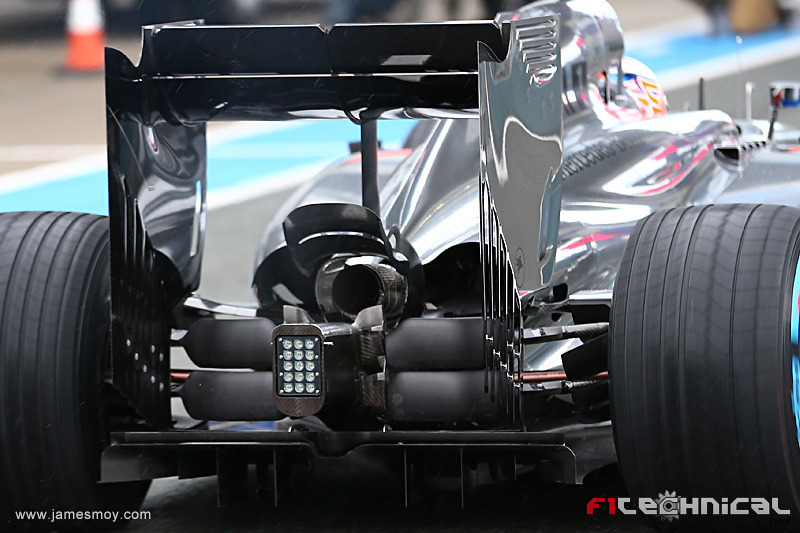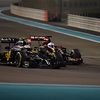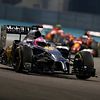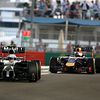McLaren MP4-29 technical analysis
McLaren's car debuted today on track at Jerez, a day late as the team struggled through Tuesday to get its car up and running. Several electrical and hydraulic systems failed to work together even after a successful fire up at the team's factory one week earlier.
The wait was however worth it, and as is is very often the case, the car that was launched on Friday crucially left out several of the more interesting technical bits.
First off is the front wing, although that seems to be a fairly conservative development of a 2013 wing. The panels are still largely the same, although there is some modification in the stacked panels. The endplates on the other hand do not feature slot gaps as with most other teams and simply end up with a vertical fence ahead of the front wheels.
The nose is yet another finger nose implementation, albeit with a shorter tip and an upper surface that continues as the nose cone widens up - at the point where the front wing supports originate. It's still quite elegant but could have been even better if the team decided to leave the finger unpainted.

The entire design is fairly smooth also thanks to the much lowered monocoque which features a gradual slope from approximately 550mm height at the front bulkhead to around 625mm at the front end of the cockpit opening. It's a radical step away from the design of the troubled 2013 car, partly influenced by the team's wish to do away with the front pull rod suspension. This notoriously caused a lot of aerodynamic issues on the McLaren MP4-28 that the team was not willing to go through again.
As such the front suspension was entirely redesigned, ending up with nearly horizontal wishbones and a pushrod that connects to the chassis as high up as possible. The entire suspension does look like a conventional layout, but it was very much an intentional change. The team's Managing Director, Jonathan Neale, confirmed that McLaren have been very pragmatic about the regulation changes, creating a platform that responds well to changes and can be more easily developed than previous McLarens.
Just like the other teams, McLaren is already preparing an update package for the first race, considering the current design a baseline to make sure the car could go on the racetrack and reliably get through the the first tests.
The sidepods are another proof of McLaren's conservative initial approach as the car features large cooling inlets, possibly the largest of any 2014 car. They do however taper down nicely towards the back, including a very elegant coke bottle shape that will help provide a decently clean airflow towards the rear of the car.
Hot air from within the sidepods is then pushed out through two channels on each side of the exhaust, exiting above the suspension arms, higher up than what is visible on the Ferrari F14T or the Red Bull RB10.
What is new compared to the launched McLaren is a small cooling outlet at the leading edge of the sidepod, just aside of the sidepod panel. The element is black and is shaped like a wing but is open on the back and at the top.
The team also fitted a brand new rear wing to its car at the test, featuring a slot at the leading edge of the sidepod panel, similar to last year's design. The extensive fins at the rear end of the endplate are however very new, although it's a development seen on several cars as they do help to reduce pressure underneath the rear wing and therefore increase downforce.
Butterfly suspension
As for basics however, that's about it, as a closer look at the rear suspension reveals this is an area where McLaren clearly haven't worried about being conservative. Instead they designed something that is very hard to compare with anything seen on other Formula One cars.

Rather than thin wishbones to keep drag as low as possible, McLaren have designed very thick elements, almost closing off the back of the car from down to the floor up to the exhaust pipe. The result is obviously a low pressure area behind it, possibly in an attempt to aid the diffuser in its extraction of air from underneath the floor.
BBC's technical expert Gary Anderson has suggested that the openings between the elements increase as the car speeds up due to suspension movement, but personally I have only seen very little movement that is unlikely to alleviate much of the aerodynamic drag that these elements are going to generate. The team nonetheless believe this to be a worthwhile development, perhaps trading off top speed at the straight for added traction out of corners. Time will tell of course, but the elements do not appear to be too easy to copy for other teams, once they'd find out they're great additions to their own cars.
A full review of the legality of the suspension and its aerodynamic purpose can be found in a dedicated analysis in the devblog.
Finally, a last mention goes out to the new monkey seat that is clearly aimed at extracting some downforce out of the exhaust gases. Contrary to several other teams though, none of the monkey seat's elements have thermal resistive coating applied.
We certainly can expect lots of changes on the McLaren, especially now that McLaren have completed the hiring of Peter Prodromou and Dan Fallows, both from Red Bull Racing, and Ettore Griffini and Ciaron Pilbeam from Lotus have joined the team. Neither of them have had any influence on the car as it is now, but may have their say as soon as they join the team.







